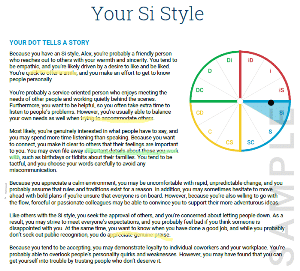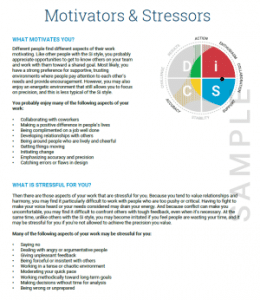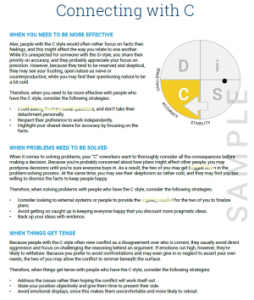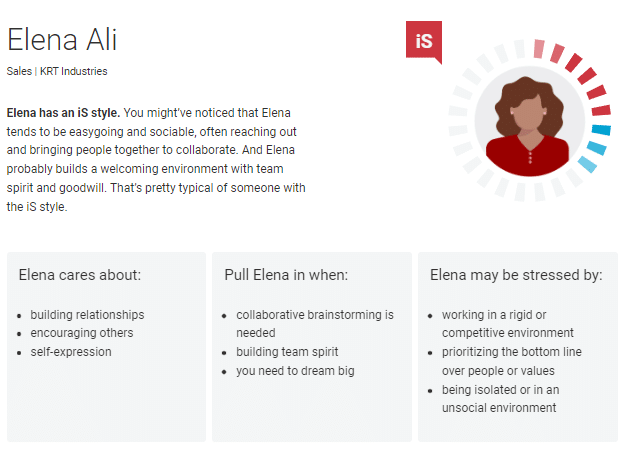Congratulations on completing your Everything DiSC® assessment. (If you took a version of DISC not based on the Everything DiSC model, sorry, but this article won’t apply to you.)
How can you use your Everything DiSC profile?
Learn about yourself
We’re going to assume that you took Everything DiSC Workplace since that is the most popular of the Everything DiSC profiles. Each profile, nevertheless, will provide you with a summary of your own style.
The content here is based on where your dot falls in the Everything DiSC circle. For example, if you’re an S style, your report will most likely read differently from another person with an S style.
The first thing we suggest doing is reading the first five pages of the profile to learn more about DiSC and about yourself. Go through pages 4 and 5 carefully, with a pen or marker in hand. Highlight what you feel proud of and what you might want to include in a cover letter, resume, or profile. Put a check mark next to, or highlight in another color, the descriptions you might disagree with or have concerns about.


You can go over this part of your profile report with a friend or colleague to get another perspective on your behaviors and priorities. Ask for examples of when your friend or colleague has seen the behaviors or attitudes in your profile. If you work with a coach or mentor, that person will also benefit from your sharing of this information and discussing it. Reflecting on your style with others will provide an additional depth to the insights in your profile.
Your style doesn’t limit how you choose to behave. If you find that some behaviors aren’t working for you in a particular situation, you can work on choosing another. What works well in one circumstance might not be the most successful in another. You probably flex into behavior more common to other DiSC styles with some regularity.
Look at page 6 and consider how you knowing your priorities can make it easier for you to express them clearly. It’s always easier to work with someone who makes their needs and priorities clear. That way you can negotiate around them. For example, if you see that you prioritize collaboration, but your boss or others on your team value accuracy more highly, you can discuss ways to meet both your goals and theirs.
Take time to consider what page 6 is telling you. If you like to journal, these items should give you plenty to write about and reflect upon. How can you increase what motivates you? How can you ask for more? How can you decrease what is stressful for you? Are there skills you could learn that would make some of these items less stressful? Do you want to share any of this with your boss, partner, or loved one?
Pages 4–6 are great to review before a job interview or a performance review. They provide some language you can use in those situations.
Learn about others
The next few pages of the profile, pages 8–15, will give you some insight into how you probably relate to others. We all have our unique styles, personalities, and priorities. These pages summarize how you might react to others, especially initially. It will help you understand what motivates others and where you might be making incomplete judgments of people.
You’ll notice that the style that is directly opposite yours can be difficult to work with, or sometimes be highly valued because of your differences. Think of someone you have difficulty with and consider if they might have this style.
Pick one of these styles and see if you can identify someone you think might reflect this style. Be aware that at this point you’re just making an assumption unless you know their Everything DiSC style. Nevertheless, it can be helpful to read the description of another style and be curious about it. You can test your assumptions by asking the person you identified about their priorities. Does their differing priority make it hard for them to work with you? For you to work with them? Can you see how working with another style might improve the results for your team?
Apply what you’ve learned
Pages 12–15 of the Workplace profile give you strategies for working with others. You’ll notice that even people with a similar style can be challenging. Highlight some of the points you want to remember and think might improve your relationships. Try one of these strategies and see what happens.
Keep this report available for review the next time you’re having a hard time understanding a coworker. See if it doesn’t give you some additional insight.
The last few pages provide you with more information about the 12 styles within the DiSC model instead of looking at just the four more broadly defined types.

Compare your style with others

If your DiSC administrator has given you access to the Catalyst platform or the MyEverythingDiSC.com site, sign in and start exploring. You’ll have access to your report and have options for comparing your style with others.
You can also practice people-reading by guessing the styles of others and considering ways your differing or similar styles affect your relationships. Consider giving Everything DiSC Workplace as a gift to someone who hasn’t experienced it and then discussing your style differences and similarities.

